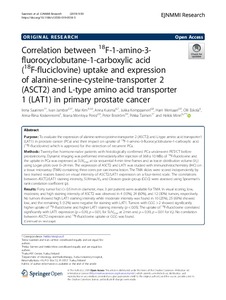Correlation between 18F-1-amino-3-fluorocyclobutane-1-carboxylic acid (18F-fluciclovine) uptake and expression of alanine-serine-cysteine-transporter 2 (ASCT2) and L-type amino acid transporter 1 (LAT1) in primary prostate cancer
Irena Saarinen; Ivan Jambor; Mai Kim; Anna Kuisma; Jukka Kemppainen; Harri Merisaari; Olli Eskola; Anna-Riina Koskenniemi; Ileana Montoya Perez; Peter Boström; Pekka Taimen; Heikki Minn
https://urn.fi/URN:NBN:fi-fe2021042824124
Tiivistelmä
Purpose: To evaluate the expression of alanine-serine-cysteine-transporter 2 (ASCT2) and L-type amino acid transporter1 (LAT1) in prostate cancer (PCa) and their impact on uptake of F-18-1-amino-3-fluorocyclobutane-1-carboxylic acid (F-18-fluciclovine) which is approved for the detection of recurrent PCa.
Methods: Twenty-five hormone-naive patients with histologically confirmed PCa underwent PET/CT before prostatectomy. Dynamic imaging was performed immediately after injection of 368 +/- 10 MBq of F-18-fluciclovine and the uptake in PCa was expressed as SUVmax at six sequential 4-min time frames and as tracer distribution volume (V-T) using Logan plots over 0-24 min. The expression of ASCT2 and LAT1 was studied with immunohistochemistry (IHC) on a tissue microarray (TMA) containing three cores per carcinoma lesion. The TMA slides were scored independently by two trained readers based on visual intensity of ASCT2/LAT1 expression on a four-tiered scale. The correlations between ASCT2/LAT1 staining intensity, SUVmax/V-T, and Gleason grade group (GGG) were assessed using Spearman's rank correlation coefficient (rho).
Results: Forty tumor foci (>0.5 mm in diameter, max. 3 per patient) were available for TMA. In visual scoring, low, moderate, and high staining intensity of ASCT2 was observed in 4 (10%), 24 (60%), and 12 (30%) tumors, respectively. No tumors showed high LAT1 staining intensity while moderate intensity was found in 10 (25%), 25 (63%) showed low, and the remaining 5 (12%) were negative for staining with LAT1. Tumors with GGG >2 showed significantly higher uptake of F-18-fluciclovine and higher LAT1 staining intensity (p<0.05). The uptake of F-18-fluciclovine correlated significantly with LAT1 expression (rho = 0.39, p=0.01, for SUVmax at 2 min and rho = 0.39, p=0.01 for V-T). No correlation between ASCT2 expression and F-18-fluciclovine uptake or GGG was found.
Conclusions: Our findings suggest that LAT1 is moderately associated with the transport of F-18-fluciclovine in local PCa not exposed to hormonal therapy. Both high and low Gleason grade tumors express ASCT2 while LAT1 expression is less conspicuous and may be absent in some low-grade tumors. Our observations may be of importance when using F-18-fluciclovine imaging in the planning of focal therapies for PCa.
Kokoelmat
- Rinnakkaistallenteet [27094]
